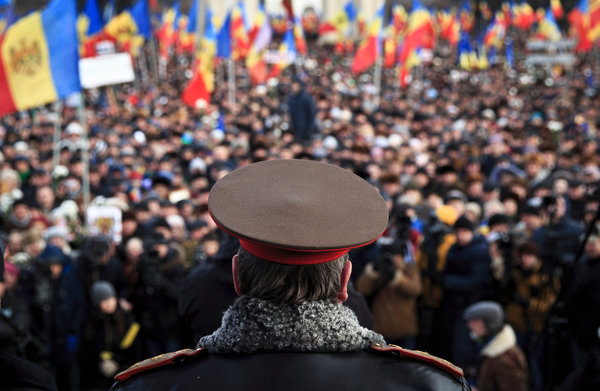
Moldovan Anti-Government Protests Unify Pro-Western, Pro-Russia Groups Across Ethnic Lines (Part One)
Publication: Eurasia Daily Monitor Volume: 13 Issue: 19
By:

From January 20 through 24, tens of thousands of angry protesters rallied in Chisinau each day in -10° C (14° Fahrenheit) temperature to demand the resignation of the just-installed government, dissolution of the parliament—both institutions are now controlled by the billionaire Vladimir Plahotniuc—and new parliamentary elections. The atmosphere is one of barely contained wrath against the corrupt ruling establishment, Plahotniuc being its current personification. Mass rallies are set to resume, and civil disobedience actions to be launched, after the expiry of a four-day “ultimatum” tonight (January 28).
Unprecedently for Moldova, the crowds’ composition cuts across ethnic, linguistic, ideological and party lines. Certain Western embassies seek to defuse the confrontation (Jurnal.md, January 28). A Western-brokered de-escalation could turn the leaders of Moldova’s pro-Russia parties, Igor Dodon and Renato Usatii, into legitimate political players, since their parties—the Socialists and Our Party—have joined Moldova’s pro-Western politicians and civil society, pressing the same set of demands (see above) with combined efforts.
For the first time in Moldova’s 25 years of independence, this public movement is drawing together citizens of various ethnicities, different political loyalties, and contradictory “geopolitical” preferences. Those deep divisions now seem to be transcended by a shared outrage over misgovernance and widespread pauperization. Protesters denounce high-level corruption, the “oligarchy” (in Moldova a one-man phenomenon, Plahotniuc), and the new government which is widely deemed to have taken power illegitimately. That general sense of indignation seems to become a unifying factor in an otherwise deeply fragmented populace.
Moldova’s polity is splintered along multiple lines into Romanian-speaking and Russian-speaking; leftists of socialist or communist persuasions versus democrats who are deemed “rightists” by default; those clinging to the Soviet heritage as against those repudiating it (directly affecting their respective attitudes toward Russia); holders of this or that citizenship (many of them holding multiple passports) with fluid loyalties; and ultimately, supporters of the European orientation versus sympathizers of Russia’s Eurasian project—to name only the main faultlines. Some of those segments are themselves subdivided, such as Moldovanists versus Romanianists (the latter being split even further between “statists” for independent statehood and “unionists” for unification with Romania); while ethnic Russians are actually outnumbered by “Russian-speaking” non-Russian minorities, some of which form majorities in parts of the country.
Moldova’s population and its voters are probably the most deeply and intricately fragmented in all Europe. Political and cultural communications between these segments are uneasy, often acrimonious; and any political alliances between these segments’ representatives are unstable combinations, as is the polity built on such bases.
Those entrenched divisions made it impossible to build a national consensus about the direction of Moldova’s development during the 25 years of independence. But those divisions are now being transcended through the general aspiration to remove high-level corruption from the “captured state,” divest “oligarchs” of illicitly acquired assets, and remove the “usurper government” through free parliamentary elections. This is a consensus on the lowest common denominator, perhaps a temporary one, given its specific terms of reference. Moldovan observers note that Plahotniuc has perversely “succeeded” in unifying practically all social segments, for the first time in 25 years: in this case against what is perceived as Plahotniuc’s regime. Yet Plahotniuc can only be a temporary and only a negative unifying factor.
Nevertheless, some local observers and a few astute external ones perceive here the first-ever basis for the development of a more stable, more inclusive political consensus in Moldova. Initial analogies are being drawn between the events in Chisinau and those on Kyiv’s Maidan two years ago. There, the revolt against high-level corruption and its personification in then-president Viktor Yanukovych unified protesters across ethnic and linguistic lines, just as the issue of corruption and the figure of Plahotniuc unified Moldova’s otherwise diverse protest forces. Kalman Mizsei, from his comparative perspective as the former envoy of the European Union to Moldova (2007-2011) and current head of the EU’s civilian security sector reform in Ukraine (since 2014) has noted those commonalities of both cases, alongside the specificities of either (Jurnal.md, January 22).
Moldova’s pro-Western, Romanian-speaking civil society groups are those who launched the initiative to unify the two streams of protest: the pro-Western center-right and the pro-Russia Left, at least at the present stage. On January 18, two days before the start of mass demonstrations, a Civic Forum in Chisinau, attended by the elite of Moldova’s civil society, with a sprinkling of local Russian/Russophone participants, passed this resolution:
“Those seeking to be free from oligarchic power must combine their efforts, regardless of their national-ethnic-linguistic identities or geopolitical preferences. We encourage all the sound political forces to unite, under watchwords of freeing the state from capture, introducing the rule of law, returning to democratic norms and procedures (sic). This is our common purpose, and no geopolitical daydreams should separate us from one another. In the existing circumstances, any return to normalcy and to democracy presupposes holding pre-term elections” (Unimedia, January 18, 19).




